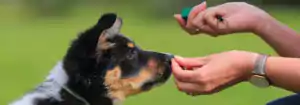5 Amazing Puppy pets training
Do you currently have a new pets at home? Then find useful tips:

What the book provides:
- fundamentals of pets training
- home invasion guidance
- Methods for crate training
- sleep hygiene methods
- bite prevention advice
5 Amazing Puppy training
- Positive reinforcement is one of the most efficient and compassionate training methods for pets. Using this technique, you can give your pets cookies, compliments, or affection in exchange for excellent behaviour. This encourages your pets to repeat the behaviour by creating a positive association between the desired behaviour and the reward.
- Consistency: When a pets, consistency is essential. It’s crucial to consistently utilise the same commands, training methods, and rewards. This will make learning easy for your dog and help them grasp what is expected of them.
- Socialization: Your pets should include socialisation. They must be exposed to many people, animals, and settings in order to develop their comfort and confidence in a range of circumstances.
- One of the most crucial lessons to teach your pets is potty training. Crate training, planned excursions outside, and positive reward for successful bathroom breaks can all be used to accomplish this.
- Teaching your pets the fundamentals of obedience, such as “sit,” “stay,” “come,” and “heel,” will help establish you as the pack leader and make it simpler for them to comprehend and comply with instructions in other training domains.
It’s crucial to keep in mind that you should begin teaching your pets as soon as you bring them home. This will speed up their learning process and make it more fun for both you and your new pet. When training a pets, it’s also crucial to be patient and consistent because they are still learning and may make mistakes.
Even how to “Pets proof” your home will be taught to you!
The comprehensive guide to pets training, pets Training: The Comprehensive Guide to pets Training – A Step by Step Activity Guide to: Housebreaking, Crate Training, pets Sleep Training and More, teaches you all the fundamentals of pets training.
You’ll learn what the best toys and treats are for your dog, as well as how to choose collars, leashes, and harnesses. Crates, bedding, and fences are also covered in this book.
Simple, effective, and quick technique!
Can’t take owning a disobedient dog any longer?
Are you sick of cleaning up your dog’s faeces and urine all day long and having a stinky house?
Can’t bear it when your dog bites your hands, feet, and other body parts, destroys your belongings, and disobeys you at all times because he won’t accept being misunderstood?
What the book provides
- Discover how to raise the ideal dog.
- Find out how to train and socialise a new dog.
- Learn the basics of the discipline of learning theory.
- Learn how to evaluate the performance of various behaviour change techniques.
- Find out how to train your dog to be a polite canine companion.
- Learn how to properly educate your dog to remain in control when off-leash, away from other dogs, and around distractions.
- Learn to reduce the use of food and other rewards from outside sources during training

Pets training maintenance can be an ongoing procedure that calls for tolerance, consistency, and commitment. Here are some pointers to keep your pets up to date:
- Practice frequently: It’s crucial to practise frequently to keep your pets training up to par. This entails reviewing the commands and cues your pets has learnt each day and giving them positive reward.
- Be dependable: When it comes to sustaining pets, consistency is essential. For your pets to understand what is expected of them, use the same orders and methods each time.
- Use positive reinforcement: This method of keeping up pets is beneficial. When your pets correctly complies with your directions, treat them, give them praise, or show them some love.
- Gradually raise the bar: As your pets gains experience in obeying commands, raise the bar on the challenges you provide to them. This will help to maintain their interest and motivation.
- Shorten sessions: Short sessions will prevent your pets from being overwhelmed or bored. As your pets gains experience, gradually lengthen the sessions from 5 to 10 minutes.
- Consider your pets body language and their emotional condition as you remain conscious of their behaviour. Take a break or end the lesson if your pets appears to be exhausted, stressed out, or frustrated.
- Maintain rules and limits consistently: Once your pets has mastered a rule or boundary, it’s crucial to continue to enforce it. This will make it simpler for your pets to obey your directions and will help them grasp what they can and cannot do.
- Keep up with socialisation: As your pets grows, be sure to expose them to a variety of people, animals, and situations. Socialization is a crucial component of pets.
Find this below video :




